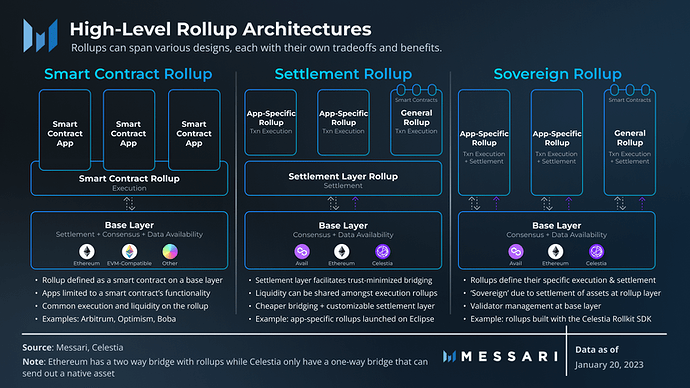Two Layers of a Rollup
The Jakarta protocol proposal introduces Transaction Optimistic Rollups (or TORUs) as the first (and experimental) implementation of optimistic rollups on Tezos.
TORUs are a scaling solution to improve TPS on Tezos.
At Layer 1 protocol level, a TORU has its own address, that compactly represents off-chain transaction execution and state updates. Assets can be deposited to the rollup – and withdrawn – by accounts, smart contracts and other rollups.
To run a TORU, a Layer 2 operator processes the transactions and update the state to reflect the changes. This operator only posts a receipt back to the main chain, summarizing the new state of the rollup as a cryptographic hash.
We can think at this behavior as a Layer 1 rollups factory that allows Layer 2 operators develop and run their off-chain nodes. This also gives them freedom to implement their own policies regarding fees and incentives. This offers diverse alternatives: being completely altruistic, whitelisting operations for specific projects, creating an off-chain subscription service or implementing their own L2 gas model based on e.g., cTez tickets.
The reason for this post
As TORU is just a new proposal, there is no standard and supported implementation for a rollup node, which makes complicated to experiment with TORUs on Tezos.
Marigold, Nomadic Labs, TriliTech, Oxhead Alpha, Tarides, DaiLambda, Functori & Tweag have developed an experimental rollup node. This post aims to explain how to set it up to make experimentation easy… and maybe give you amazing project ideas with rollups and Tezos.
How to Deploy
Prerequisite
You must know how to setup an environment from scratch
Get unreleased Tezos binaries
First, run the below commands:
git clone git@gitlab.com:tezos/tezos.git
cd tezos
git checkout master
opam init # if this is your first time using OPAM
make build-deps
eval $(opam env)
make build-unreleased
export PATH=$(pwd):$PATH
Set Jakartanet Tezos endpoint as default. You can use Marigold testnet node with this command:
$ tezos-client --endpoint https://jakartanet.tezos.marigold.dev config update
Create your wallet
Create a new key pair, which will be named mykey:
$ tezos-client gen keys "mykey"
Create a faucet wallet and transfer Tez to your wallet
The easiest way to get some testnet Tez is through the faucet website. Download the JSON file and rename it to faucet.json, then run the following to transfer from the faucet to our wallet:
$ tezos-client activate account faucet with faucet.json
$ tezos-client transfer 100 from faucet to mykey --burn-cap 0.5
Create Rollup
Execute this command to originate a transaction rollup:
$ tezos-client originate tx rollup from mykey --burn-cap 100
The last command will output a result similar to this (you will need the yellow information):
Estimated storage: no bytes added
Estimated gas: 1420.108 units (will add 100 for safety)
Estimated storage: 4000 bytes added (will add 20 for safety)
Operation successfully injected in the node.
Operation hash is 'opPs1d922NToh1Cz9Yv4BA9xUmnH66jATQcHwv7GFuGhaARg6K1'
Waiting for the operation to be included...
Operation found in block: BM1cyUa9pqcQ6HERd3pwL3ZQfBovau4RXYYTji7EXYscMHftHD2 (pass: 3, offset: 0)
This sequence of operations was run:
Manager signed operations:
From: tz1TVH5FbvDj7cJ5YLDGCt9gMExmDdgo3T8a
Fee to the baker: ꜩ0.000358
Expected counter: 10815
Gas limit: 1000
Storage limit: 0 bytes
Balance updates:
tz1TVH5FbvDj7cJ5YLDGCt9gMExmDdgo3T8a ... -ꜩ0.000358
payload fees(the block proposer) ....... +ꜩ0.000358
Revelation of manager public key:
Contract: tz1TVH5FbvDj7cJ5YLDGCt9gMExmDdgo3T8a
Key: edpkvYpC5HJqGydSmAD6TWgnbYooNMstumXckFLGa5Qd7eEbysdLQm
This revelation was successfully applied
Consumed gas: 1000
Manager signed operations:
From: tz1TVH5FbvDj7cJ5YLDGCt9gMExmDdgo3T8a
Fee to the baker: ꜩ0.000283
Expected counter: 10816
Gas limit: 1521
Storage limit: 4020 bytes
Balance updates:
tz1TVH5FbvDj7cJ5YLDGCt9gMExmDdgo3T8a ... -ꜩ0.000283
payload fees(the block proposer) ....... +ꜩ0.000283
Tx rollup origination:
From: tz1TVH5FbvDj7cJ5YLDGCt9gMExmDdgo3T8a
This tx rollup origination operation was successfully applied
Balance updates:
tz1TVH5FbvDj7cJ5YLDGCt9gMExmDdgo3T8a ... -ꜩ4
storage fees ........................... +ꜩ4
Consumed gas: 1420.108
Originated tx rollup: txr1hm5soQNtN1N4j1Fu5mMSPyPVeACgzaixq
The operation has only been included 0 blocks ago.
We recommend to wait more.
Use command
tezos-client wait for opPs1d922NToh1Cz9Yv4BA9xUmnH66jATQcHwv7GFuGhaARg6K1 to be included --confirmations 1 --branch BMByD7vQKo2RTR1ck3jmHSEbZEkawJzMsg4zZPWYNuockHXe7Wk
and/or an external block explorer.
Configure Rollup
Now that we have a operator (mykey), rollup-id (originated tx rollup), and rollup-genesis (operation found in block). We can configure the rollup node with the previous information:
$ tezos-tx-rollup-node-013-PtJakart config init on \
--data-dir "$HOME/rollups" \
--operator tz1TVH5FbvDj7cJ5YLDGCt9gMExmDdgo3T8a \
--rollup-id txr1hm5soQNtN1N4j1Fu5mMSPyPVeACgzaixq \
--rollup-genesis BM1cyUa9pqcQ6HERd3pwL3ZQfBovau4RXYYTji7EXYscMHftHD2 \
--rpc-addr 0.0.0.0:9999
Run Rollup Node
Run the rollup node with this command:
$ tezos-tx-rollup-node-013-PtJakart --endpoint https://jakartanet.tezos.marigold.dev \
run --data-dir "$HOME/rollups"
Done, now you have a rollup node running on Jakartanet testnet!
![]() This rollup node is still experimental and must not be used as is on mainnet. We encourage you to build, test and audit your own node before releasing a rollup.
This rollup node is still experimental and must not be used as is on mainnet. We encourage you to build, test and audit your own node before releasing a rollup.
If you want to know more about Marigold, please follow us on social media (Twitter, Reddit, Linkedin)!
